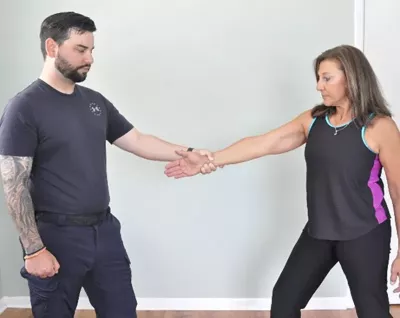I’ve been a national CE provider for almost 30 years. During my CE classes, I was surprised to learn how many therapists had clients who touched them inappropriately or verbally abused them; a few were worse than that. These stories came from both seasoned therapists and those new to the profession.
In 2015, my son, Johnny (a police officer and certified defensive tactics instructor), and I (a licensed massage therapist, massage school owner, and third-degree black belt) developed an NCBTMB-approved self-defense CE seminar for massage therapists that combined what police officers learn, what I’ve learned as a martial artist, and what I do as a massage therapist.
As a bodyworker, I have never had any client do or say anything inappropriate. Why is that? What do I do in the treatment room that keeps clients from doing anything inappropriate?
Johnny and I realized other therapists need to understand what we knew. To do that, our course “Protecting Your Assets: Self-Defense for the Healthcare Professional” came to life. Over the past decade of our self-defense teachings, so many therapists have said, “I wish I learned this in school.” To our shock, we had many therapists come forward and share unpleasant situations they went through with a client.
Massage therapists are generally in a 10 × 12 room with a stranger, a client they have seen multiple times, or someone they know personally. Therapists were shaken up and did not know what to do in many of those scenarios. These conversations made me realize the need to educate therapists about how to prevent or handle unwanted behavior from their clients and remain safe.
Do you think about remaining safe when you are giving a massage? Have you ever:
-
Felt uneasy when a client’s behavior crossed professional boundaries, unsure how to respond?
-
Felt vulnerable during late-night appointments, wishing you had the confidence and techniques to ensure your safety?
-
Had a sense of concern when a client became unexpectedly agitated, leaving you uncertain how to de-escalate the situation without compromising your safety?
Now that we have awakened one or more of those memories, pick one and see what message they have for you—not for being fearful as much as being awake, aware, and cautious. Let’s elevate your practice and gain the habits to empower your personal safety.
Setting the Stage
The first step in protecting yourself as a massage therapist isn’t necessarily taking a self-defense class, although that’s a wise choice. The first step is to properly set the stage. Evaluate your advertising to ensure you convey a professional tone. Your business cards should include your full credentials so potential clients understand the service you provide is therapeutic.
Having boundaries shows how professional you are and tends to make your clients respect you more.
You must take control from the beginning. There needs to be proper communication portraying verbal confidence the first time you meet a client. This can be via phone, text, or email. Always be professional with your words. Physical confidence must also be communicated. You control how you look at them, how you introduce yourself, how you communicate, and how you physically work on them in the treatment room. Professional attire will also send an appropriate signal. Don’t set yourself up to be misunderstood. Resist the temptation to dress informally and keep jewelry to a minimum.
Situational Awareness
Protecting yourself and having the ability to handle unwanted and unacceptable behavior is a top priority. Self-defense is not just about fighting, it’s also about not getting into a fight or confrontation.
It starts with situational awareness. Situational awareness is defined as being aware of our surroundings. Too many people do not pay attention to what’s around them. The stories from inside and outside the therapy room are endless. A student in my massage school is also a yoga instructor. She had one of her male yoga students come in for a clinical massage. He texted her afterward, saying, “Did it feel as good to you? It felt so good to have your hands on my body.” She was disturbed by that because she had pure intentions and strong personal boundaries. She responded by texting him that he crossed the line. She also told him he would never be on her massage table again. She did not expect that awkwardness from her yoga student. He appeared to be someone who wouldn’t do what he did, but never assume.
Confidence
Another therapist I know did not enforce personal boundaries. She was providing massage to a male client and he began to make her uncomfortable by asking personal questions. She didn’t have the confidence to tell the client she didn’t feel comfortable talking about her personal life.
Confidence to have strong personal boundaries is a big part of how we handle what goes on in our treatment rooms. Building self-confidence promotes personal growth that positively influences both your professional and personal life. Confidence isn’t about being perfect. It’s about being comfortable with who you are and knowing that you’re valuable. Everyone can learn how to be more confident in different, powerful ways. What may work for some may not work for others. Remember that you can always start small before taking bold strides. Here are some ways to build self-confidence:
-
Stop comparing yourself to others.
-
Embrace your failures and view them as learning opportunities.
-
Treat yourself with respect.
-
Dress in a way that makes you feel confident.
-
Stand up for yourself.
-
Read books and listen to podcasts that encourage self-confidence and positive self-talk.
Self-Defense Techniques
What if a client became aggressive and attempted to grab you? What would you do? Here are some ways to protect yourself.
The following situation happened to a therapist, where a client reached up and grabbed the therapist. Image 1 shows an example of how to get the client pushed back down and an opportunity for the MT to leave the room.

This is called the sit-down button. With a firm, pointed hand, jab the suprasternal notch at the base of the throat. This will push the person back down. It’s one of the most effective places to jab an attacker. The attacker will be surprised and will gasp or cough uncontrollably. Use the moment to remove yourself from the situation.
Joint manipulation is another technique we can use to control the client physically. We massage therapists understand the body and how it moves. We know the action of a joint. Joint manipulation techniques are often associated with martial arts, self-defense, law enforcement, or therapeutic practices and can be used to control a person in a nonlethal manner. However, these techniques should be used responsibly, ethically, and with proper training to ensure safety.
Here are two examples of how to use joint manipulation on a threatening client:
With the client supine, push/roll the triceps above the elbow toward the body while controlling the hand/wrist and turning the thumb down (Image 2).

With the client prone, control the wrist/hand, turning the thumb down, while putting pressure on the triceps (Image 3).

For a wrist-grab escape, if a client grabs your wrist (Image 4A), make a fist and lift your thumb (Image 4B). Rotate your hand toward the opening of their hand and lift your arm and pull out quickly (Image 4C).



If the client grabs you from behind in a bear hug, grab their finger and rip it away (Image 5).

Prevention Is Key!
In the treatment room, we have an opportunity to be proactive to prevent unwanted behavior. I am a firm believer in proper draping with all clients. Range of motion (ROM) and stretching techniques make draping skills necessary. Secure draping on the legs will provide security for both you and the client. Take the drape under the leg to be stretched, pull it up to the hip, then ask the client to hold the two ends of the sheet in order for the stretching to be performed and nothing will be exposed (Image 6).

When working on a male client, this draping is very secure. If there is an upper adductor (groin) issue on a male client that needs to be worked, confidently work this area (Image 7). You can use the same draping for a female client. Proper draping will show the client your professionalism and personal boundaries.
Other than your hands, forearms, or feet you are using to apply strokes, no other body part should touch the client. It could happen by accident, so caution is advised. Be very conscious not to have your breasts, stomach, thigh, or even your loose shirt touch the client.
Setting Personal Boundaries
Setting boundaries in relationships isn’t always easy—and there are several misconceptions about what setting boundaries means. The therapist who was asked those personal questions was hesitant to form boundaries in her career because she assumed this would make her seem mean or inconsiderate. We can’t be afraid to push others away, turn down opportunities, and just say no.
Practicing communication and physical confidence will come naturally in time. Having boundaries shows how professional you are and tends to make your clients respect you more.
A Deeper Dive—What’s Your Plan?
Would you know what to do if a client crossed the line and made you feel uncomfortable? Every massage therapist deserves to feel safe at work; but for too many, the reality is unsettling.
In the book Self-Defense for Massage Therapists, Teresa Matthews and Johnny Matthews deliver an empowering guide packed with real-world strategies to help MTs stay secure and confident in and out of the treatment room. The book covers:
- Situational awareness to identify and avoid threats
- Verbal strategies and body language to de-escalate tension
- Practical self-defense techniques anyone can learn to handle an inappropriate client
- How to have zero tolerance when a client pushes the boundaries
Drawing from stories of real incidents shared by therapists, this guide is more than instruction, it’s a call to reclaim your safety and peace of mind. The book can be ordered at amazon.com.
Having the Physical Ability
Since I can remember, I’ve been physically active. Being an athlete throughout my life, I’ve always known that strength training and stretching helped me be strong. Massage therapists practice proper stances in our body mechanics, such as the horse stance and warrior stance. Certain exercises to strengthen our leg muscles would help us hold those positions with ease.
Most defensive tactics skills require a certain amount of physical fitness: strength, agility, balance, flexibility, and endurance. Here are some self-care activities to help you with daily activities and to defend yourself.
Stretching
Incorporating stretching into your routine can lead to long-term benefits for your physical health and overall well-being.
Strength Training
Strength training offers a range of benefits for physical health, mental well-being, and overall quality of life.
Core Training
Core training provides numerous benefits that can enhance overall physical health and performance.
Cardio and Muscle Endurance
Cardio and muscle endurance refers to the ability of a muscle or group of muscles to sustain repeated contractions or maintain a prolonged level of force over an extended period. If you got into an altercation, how long do you think you could maintain your energy? You may have the strength and confidence and know what to do, but will you have the conditioning? Cardio endurance exercises offer a variety of benefits for overall health and fitness. Here are some cardio exercises to add to your routine.









